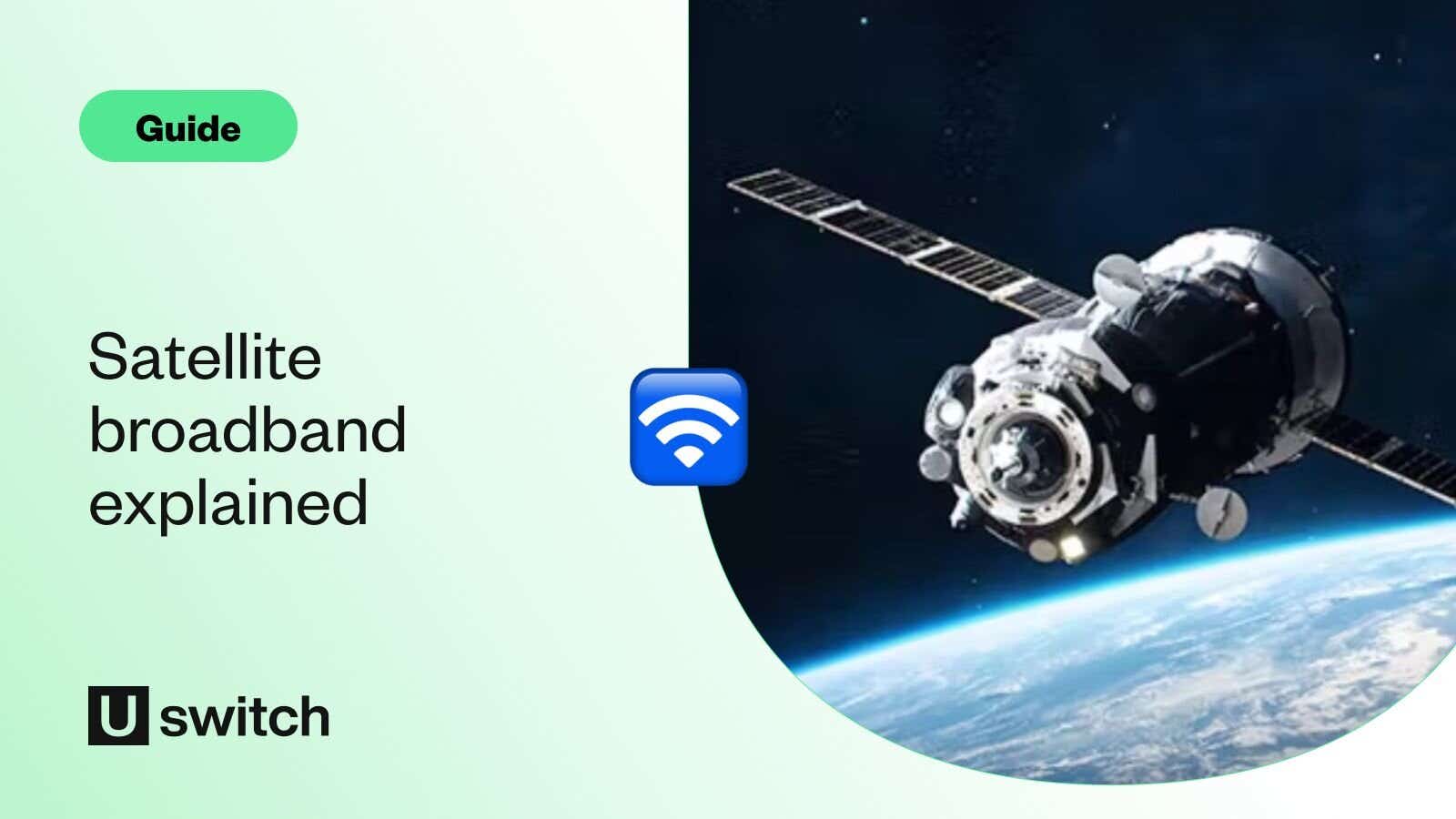Satellite broadband is an alternative way of getting internet in your home. Just like satellite TV, it’s beamed all the way from a telecoms satellite in space to a satellite dish installed on your property. It then gets hooked up to a Wi-Fi router just like normal broadband.
Because it doesn’t rely on a network of cables going into every home, it’s becoming a great option for people living in rural and remote areas of the UK.
Companies like SpaceX and OneWeb are leading the charge, with satellites that can provide internet speeds of up to 300Mbps. That’s much faster than the UK average speed, which currently stands at 69Mbps.
Read on to learn about satellite broadband, and if you could benefit from it once it becomes available to you.
What is satellite broadband?
While the nationwide rollout of full fibre will provide the majority of UK households with much faster, more reliable broadband within the next couple of years, many rural properties are unlikely to see the benefits any time soon.
This is where satellite broadband could help. It provides a home internet connection shared between a personal satellite dish and one of the many communications satellites high above us in low Earth orbit.
This means that it doesn't need any new cables from an existing fixed-line broadband network (like Openreach) to reach your property. All you technically need is your own satellite dish, and a wired connection from it to your home Wi-Fi router, which satellite companies will provide for you.
Who is satellite broadband best for?
Rural and remote homeowners would benefit the most from satellite broadband, since fixed broadband, like full fibre, is both difficult and expensive to install in far away locations.
Some properties are just too hard to reach for providers to lay physical fibre cables. But satellite connections can cover pretty much anywhere in the world (provided you have a dish to receive it).
For most Brits living in more built-up and suburban areas, a normal broadband connection would likely be the more sensible option at the moment. Fixed-line broadband deals are usually cheaper and have a slightly more consistent connection than what satellite internet can currently offer.
Compare our best broadband deals
Search on Uswitch to find the right broadband package for you.
How does satellite broadband work?
Normal communications satellites work by transmitting radio waves to antennas down on Earth. Those antennas then provide our connected devices with the signal they need to communicate, which is how mobile phone calls and mobile internet connect.
These satellites were providing internet to a small number of isolated properties for years. But the technology is quite old now, so it’s a lot slower and it can’t handle as many devices as other types of broadband.
Thankfully though, this is all changing. The latest satellite broadband companies use laser light to transmit broadband data, rather than the radio waves relied on for older satellite connections. And this provides a huge overhaul in both the speed and availability of the technology.
Both lasers and radio waves move at the speed of light, so it isn’t technically the ‘speed’ the data travels that makes the difference. However, lasers operate on a much higher frequency than radio waves do, which means much more data can be transferred through them at any given time.
That’s why we often refer to broadband speed as ‘bandwidth’, because it’s not necessarily how fast data travels, but how much data can be transmitted at once.
How fast is satellite broadband?
So what actually are the speeds you can get from satellite broadband?
Well, while older satellites could only manage average broadband speeds similar to standard copper broadband (10Mbps), Starlink, OneWeb and other satellite internet providers that they supply can now occasionally reach up to 300Mbps.
That’s comparable to speeds you can get with fixed-line full fibre broadband, which is a significant improvement upon the older technology. Those speeds could future-proof a home for years, and could finally provide an ultrafast, ultra-consistent broadband connection for the UK’s most remote households.
Which satellite internet providers are in the UK?
There are currently only two major satellite companies supplying modern satellite broadband - Starlink and OneWeb.
Starlink offers its own broadband deals through its network, but OneWeb supplies the connection for other satellite providers like Brdy and ReliaLink.
Starlink
Starlink disrupted the satellite internet industry in 2020, making satellite internet theoretically available all across the globe. In May 2019, the initial group of satellites was sent into orbit with more being sent up year on year.
It holds several advantages over its rivals - it's more widely available and it has a bigger brand reputation than some of the other smaller providers of modern satellite internet.
Is Starlink available in the UK?
Starlink has been accessible in the UK since 2021, with coverage extending across nearly the entire country.
An ISPreview report in June 2024 revealed the latest recorded average speeds for Starlink across its UK customer base:
- Average download speed: 90.7Mbps (157Mbps average for the top 10%)
- Average upload speed: 11.2Mbps (16Mbps average for the top 10%)
OneWeb - an alternative to Starlink
Eutelsat OneWeb is a subsidiary of Eutelsat, a French satellite operator based in Paris, and UK company OneWeb, which is commercially based out of London.
OneWeb started to emerge as the UK’s leading satellite broadband provider in the 2010s, but it had to restart its operations after collapsing in early 2020. The UK government then won the bid for its assets, acquiring it in partnership with Indian company Bharti Global for around $500 million.
OneWeb hasn't published a clear update on its network coverage since 2023, but one of the providers it supplies, Brdy, claims its deals have full UK coverage. So it's fair to assume that its network is now available to all UK customers too.
Does Sky offer satellite broadband in the UK?
No, Sky only supplies satellite TV to the UK. The provider has also stopped selling new satellite TV deals, in favour of its Wi-Fi-based service Sky Stream. But millions of existing Sky Q TV customers still benefit from its older satellite method.
How to get satellite broadband for rural areas
You can check Starlink’s availability to your address on the Starlink website.
You can also view deals from Brdy and ReliaLink for broadband supplied by OneWeb.
Beyond an engineer installing a satellite dish at your residence, the process closely resembles the typical procedure for acquiring a standard broadband contract (although self-installation is an option with some Starlink packages).
It's important to note that satellite internet equipment and installation is expensive, which is why the technology is viewed as a last resort for remote properties.
The initial step involves reaching out to your chosen satellite broadband provider. They will offer guidance on selecting the most appropriate package to meet your requirements. In most cases, you'll be required to make an upfront payment for installation and activation. At this stage, the provider will also assist you in setting up your monthly payment plan.
Finally, on a mutually agreed upon date and time, the installation and connection process will occur. The duration of installation may vary based on any specific challenges posed by your property, which the engineer will address. When the engineer completes the setup, your internet connection via satellite will be established.
How expensive is satellite broadband?
Satellite broadband can be very expensive, due to the equipment you need installed to use it at home and the high business costs that providers have to deal with. It’s especially pricey compared to other types of broadband that offer the same or faster speeds.
Just getting a satellite dish installed at your property for it to work can cost hundreds of pounds, and the monthly bill you’ll then be charged is often much higher than most entry-level fibre broadband deals.
These charges make satellite broadband potentially the most expensive type of broadband you can get.
Should I get satellite broadband?
For the majority of UK residents, the answer is not yet.
While its reported speeds are now quite impressive, it will be a very long time before it’s priced anywhere near the same level as the more widely available types of broadband. If your options for broadband are limited, it might have to be a consideration, but it’s best to avoid it if you can help it. At least until it becomes a much more competitive option.
Essentially, you would have to be comfortable with the cost of a satellite broadband service in order to be happy with the service you get from it. And if you’re at all concerned about price, you should definitely seek an alternative type of broadband.
While you wait for satellite broadband to find its feet, it’d certainly benefit you to browse various broadband deals in the meantime. Full fibre deals are getting cheaper and more widely-available by the year, so if you haven’t switched in a while, you could make a huge saving on a speedy package.
Browse our range of fibre broadband deals
Choose between our wide range of fibre broadband deals on Uswitch.




